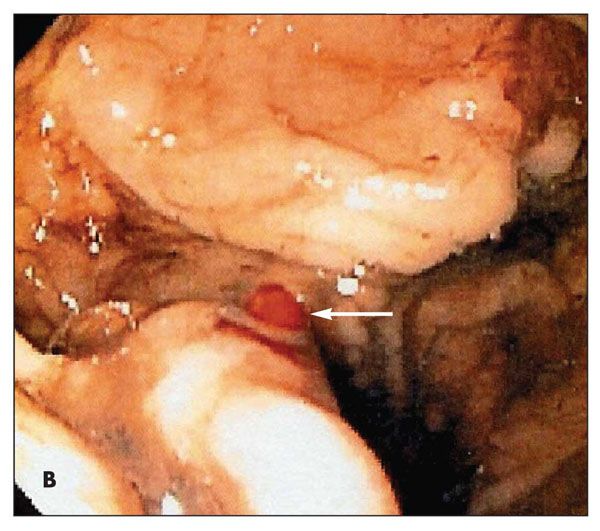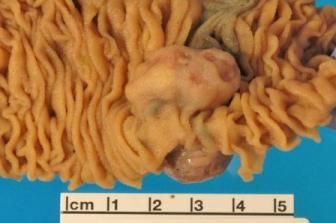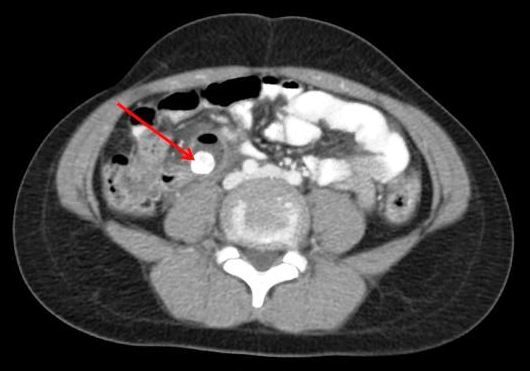- Clinical Technology
- Adult Immunization
- Hepatology
- Pediatric Immunization
- Screening
- Psychiatry
- Allergy
- Women's Health
- Cardiology
- Pediatrics
- Dermatology
- Endocrinology
- Pain Management
- Gastroenterology
- Infectious Disease
- Obesity Medicine
- Rheumatology
- Nephrology
- Neurology
- Pulmonology
10 Gastrointestinal Upsets, Part 2: A Photo Essay
Here: a close-up look at one cause of upper GI bleeds, as well as bezoars, stromal tumor, appendicolith, and Kaposi sarcoma.

Case 1:
A 70-year-old man presented with dyspnea, weakness, and lightheadedness 2 days after he was treated for suspected GI bleeding. An esophageal ultrasonogram showed a bleeding artery at the proximal fundus. Esophagogastroduodenoscopy revealed a small, red, nipple-like lesion in the proximal stomach (arrow). A histological section showed a tortuous, thick-walled blood vessel that extended through the gastric submucosa into the overlying luminal epithelium.
The ruptured vessel demonstrated necrosis, erythrocyte extravasation, and clotting with adjacent acute inflammatory exudates. The findings were consistent with Dieulafoy lesion, which is responsible for 0.3% to 6.7% of upper GI bleeding.
Patients often present with a massive upper GI hemorrhage and recurrent painless bleeding associated with severe life-threatening hemodynamic involvement. Dieulafoy lesions may be found in any portion of the GI tract. The diagnosis is based on endoscopy.
Case and Image provided by Nicole Roberts, MD, Christopher Brodkin, MD, and Charles Sturgis, MD
NEXT CASE »
For the discussion, click here.

Case 2:
A 59-year-old woman with a history of peptic ulcer disease complained of mild, burning, and nonradiating pain in the epigastrium that worsened with food intake. Upper endoscopy showed a normal gastric remnant, an ulcer at the anastomotic site, and a large bezoar on the gastric side of anastomosis. Biopsy showed vegetable fibers, confirming a diagnosis of phytobezoar.
Bezoars may be located anywhere in the GI tract but most often are found in the stomach. Phytobezoars, the most common type, are composed of indigestible cellulose, tannin, and lignin from ingested fruits and vegetables.
Prior GI surgery, poor mastication, and gastric dysmotility are risk factors for bezoar formation. Usually, patients remain asymptomatic and the onset of symptoms is insidious. Patients may present with abdominal pain, dyspepsia, nausea, postprandial vomiting, abdominal mass, early satiety, and weight loss. Complications include intestinal obstruction, bleeding, and perforation.
Case and Image provided by Ranjita Pallavi, MD and Jennifer Harley, MD
NEXT CASE »
For the discussion, click here.

Case 3:
A 55-year-old man’s capsule endoscopy showed an active area of bleeding in the duodenum or jejunum, and a 2-cm ulcerated submucosal mass 50 cm distal to the pylorus was found. An abdominal CT scan revealed a single exophytic jejunal mass. A detailed dermatologic evaluation identified café au lait spots, neurofibromas, and axillary freckling. The findings were consistent with neurofibromatosis type I (NF-1), and pathologic examination of the jejunal mass after surgical resection confirmed gastrointestinal stromal tumor (GIST).
The risk of GIST is increased 150-fold in patients with NF-1 compared with the general population. Most NF-1–associated GISTs are clinically indolent, with favorable histologic parameters.
Photograph courtesy of Reena Julka, MD and Jacqueline Keedy, MD
NEXT CASE »
For the discussion, click here.

Case 4:
A 9-year-old boy was admitted with crampy abdominal pain, emesis, and anorexia. His past medical history included an open appendectomy for acute appendicitis with perforation. CT scan of the abdomen with contrast showed a 1.1-cm calcified density in the right lower quadrant and an adjacent 1.8 x 1.8-cm fluid collection. He underwent exploratory laparotomy. The diagnosis was retained appendicolith with abscess formation. Consider the following:
• For any patient who presents with right lower quadrant pain, a high index of suspicion for appendix-related disease is necessary, regardless of a history of appendectomy.
• Retained appendicolith and stump appendicitis are rare complications after appendectomy that present symptomatically similar to acute appendicitis. They are a surgical emergency.
• Which diagnostic test is more useful-abdominal ultrasonography or abdominal CT-is unclear.
Case and Image provided by Alan T. Kelley, MD, MPH and Abby M. Geltemeyer, MD
NEXT CASE »
For the discussion, click here.

Case 5:
This unfixed specimen from a patient with Kaposi sarcoma (KS) of the stomach shows multiple reddish maculopapular lesions. Up to 25% of patients with KS have visceral involvement, and the GI tract often is affected. Although patients with GI KS typically are asymptomatic, gastric outlet obstruction and bleeding have been described. The gross appearances include macular, erythematous maculopapular, and polypoid lesions.
In addition to KS, common malignancies that involve the GI tract in patients who have HIV/AIDS include AIDS-related non-Hodgkin lymphoma and anal squamous cell carcinoma/anal intraepithelial neoplasia.
Image provided by Colan Ho-Yen, BSc(Hons), MBChB, and Fuju Chang, MD, PhD
For the discussion, click here.
For 10 Gastrointestinal Upsets, Part 1: A Photo Essay, click here.
Clinical Tips for Using Antibiotics and Corticosteroids in IBD
January 5th 2013The goals of therapy for patients with inflammatory bowel disorder include inducing and maintaining a steroid-free remission, preventing and treating the complications of the disease, minimizing treatment toxicity, achieving mucosal healing, and enhancing quality of life.
